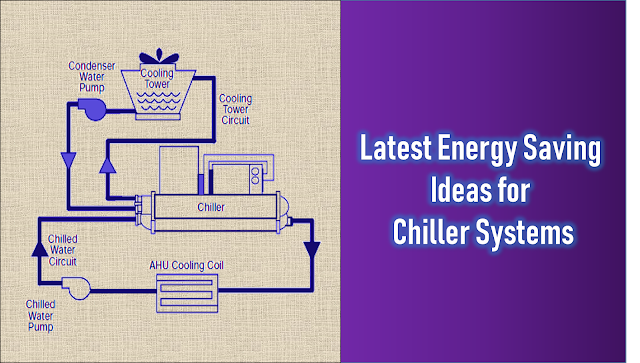Chillers are those utilities which will have a double impact on the environment. Apart from using a good amount of power to run their compressors it also uses refrigerants which can have a strong impact on global warming. Since chillers add up extra energy to existing space and emit out to the ambient, indirectly it's adding up extra heat to the atmosphere. So chiller energy efficiency should be considered on priority by the industry. Below is the list of few latest energy-saving ideas for chiller systems:
- Increase the chilled water temperature setpoint if possible.
- Use the lowest temperature condenser water available that the chiller can handle (Reducing condensing temperature by 5.5°C, results in a 20 - 25% decrease in compressor power consumption)
- Increase the evaporator temperature (5.5°C increase in evaporator temperature reduces compressor power consumption by 20 - 25%) - Chilled Water Reset Strategy
- Use adiabatic cooling pads for air-cooled condensers.
- Use an indirect evaporative cooling module to reduce the load on the cooling coil and see chiller power consumption.
- Avoid low delta T syndrome by properly planning the distribution system.
- Use pressure independent control vales near AHU units which are more energy efficient.
- Clean heat exchangers when fouling indication is flagged. Generally, if the condenser approach is more than 4 Degree C it's evident that the fouling is present in condenser tubes (1 mm scale build-up on condenser tubes can increase energy consumption by 40%). Use ATCS instead that can maintain the condenser approach in the range of 2-4 Deg C
- Optimize the condenser water flow rate and refrigerated water flow rate. There is an excellent opportunity in getting energy savings by reduced flow rate technique.
- Replace old chillers with High COP Maglev chillers.
- Use water-cooled rather than air-cooled chiller condensers.
- Replace belt-driven AHU fans with EC fans which have around 15 - 20% savings on electrical energy consumed
- Use energy-efficient motors for continuous or near-continuous operation.
- Specify appropriate fouling factors for condensers.
- Do not overcharge oil.
- Install active refrigerant agents to avoid oil fouling and get energy savings up to 7%
- Install a control system to coordinate multiple chillers.
- Study part-load characteristics and cycling costs to determine the most efficient mode for operating multiple chillers.
- Run the chillers with the lowest operating cost or lowest SEC ( Find how to calculate SEC for your water-cooled chiller) to serve baseload.
- Avoid oversizing -- match the connected load.
- Isolate off-line chillers and cooling towers.
- Establish a chiller efficiency-maintenance program. Start with an energy audit and follow-up, then make a chiller efficiency-maintenance program a part of your continuous energy management program.
- Use simple Air Washers in case of industrial applications where humidity control is of not that important
- Look for installation of alternate cooling solutions like Radiant cooling.






Thanks for posting this info. I just want to let you know that I just check out your site and I find it very interesting and informative. Commercial chiller repair phoenix I can't wait to read lots of your posts
ReplyDeleteI got some valuable points through this blog. Thank you sharing this blog. Nathers Assessment
ReplyDelete